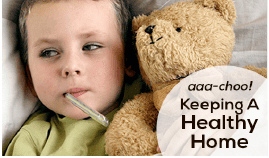Home Safety Checklist for Preschoolers
A parent’s top priority is keeping his or her children safe. Toddlers and preschool age children spend much of their time in the house, so it’s essential that parents safeguard the home to prevent injuries and accidents. Follow this room-by-room checklist to keep small children out of harm’s way.
Bathroom
- Set your hot water heater to 125 degrees. Most hot water heaters are pre-set at 140 degrees, which could burn a child in less than three seconds.
- Keep all medications and vitamins out of sight and out of reach of small children.
Bedroom
- To prevent falls, position beds and dressers away from windows. Lock windows or use window guards to limit how far the window will open.
- Ensure that cords for window blinds are out of reach, as this can pose a strangulation threat.
- Mount heavy furniture to the wall so that it won’t tip over should a child climb on it.
- Make sure there is a working smoke alarm in or near children’s bedrooms.
Living Room
- Place breakable items on high shelves.
- Only allow your child to play with age-appropriate toys. Check toys for small or loose parts that are a choking hazard.
- Install anti-tipping devices on televisions and bookcases.
- Use table guards to cover sharp corners.
- Block access to the fireplace with a gate or barrier. Keep fireplace tools and accessories out of reach.
Kitchen
- Keep hot food and liquids pushed back on the counter and out of reach from children.
- When cooking on the stove, turn pot handles toward the back of the stove or use the back burners.
- Place knives, scissors, and other sharp objects out of reach of children.
- Remove small magnets from the refrigerator.
Laundry Room
- Keep laundry detergent and other cleaning supplies out of sight and reach. Store them in original containers to easily access ingredients if accidentally ingested.
- Store the iron out of reach, especially immediately after use.
In addition to these room-specific tips, outlet covers, doorknob covers, baby gates, and cabinet locks should be used throughout the house as needed. Stay safe!
Make Water Safety Your Priority
Swimming is the most popular summer activity. The best thing you can do to help your family stay safe is to enroll in age-appropriate swim lessons.
Follow these safety tips whenever you are in, on or around water.
- Swim in designated areas supervised by lifeguards.
- Always swim with a buddy; do not allow anyone to swim alone. Even at a public pool or a lifeguarded beach, use the buddy system!
- Ensure that everyone in the family learns to swim well. Enroll in age-appropriate Red Cross water orientation and Learn-to-Swim courses.
- Never leave a young child unattended near water and do not trust a child’s life to another child; teach children to always ask permission to go near water.
- Have young children or inexperienced swimmers wear U.S. Coast Guard-approved life jackets around water, but do not rely on life jackets alone.
- Establish rules for your family and enforce them without fail. For example, set limits based on each person’s ability, do not let anyone play around drains and suction fittings, and do not allow swimmers to hyperventilate before swimming under water or have breath-holding contests.
- Even if you do not plan on swimming, be cautious around natural bodies of water including ocean shoreline, rivers and lakes. Cold temperatures, currents and underwater hazards can make a fall into these bodies of water dangerous.
- If you go boating, wear a life jacket! Most boating fatalities occur from drowning.
Prevent Unsupervised Access to the Water
- Install and use barriers around your home pool or hot tub. Safety covers and pool alarms should be added as additional layers of protection.
- Ensure that pool barriers enclose the entire pool area, are at least 4-feet high with gates that are self-closing, self-latching and open outward, and away from the pool.
- The latch should be high enough to be out of a small child’s reach.
- If you have an above-ground or inflatable pool, remove access ladders and secure the safety cover whenever the pool is not in use.
- Remove any structures that provide access to the pool, such as outdoor furniture, climbable trees, decorative walls and playground equipment.
- Keep toys that are not in use away from the pool and out of sight. Toys can attract young children to the pool.
Maintain Constant Supervision
- Actively supervise kids whenever around the water—even if lifeguards are present. Do not just drop your kids off at the public pool or leave them at the beach—designate a responsible adult to supervise.
- Always stay within arm’s reach of young children and avoid distractions when supervising children around water.
- Know What to Do in an Emergency. If a child is missing, check the water first. Seconds count in preventing death or disability.
- Know how and when to call 9-1-1 or the local emergency number.
- If you own a home pool or hot tub, have appropriate equipment, such as reaching or throwing equipment, a cell phone, life jackets and a first aid kit.
- Enroll in Red Cross home pool safety, water safety, first aid and CPR/AED courses to learn how to prevent and respond to emergencies.
Contact the Training Support Center at 1-800-RED-CROSS or [email protected].
Source: http://www.redcross.org/get-help/prepare-for-emergencies/types-of-emergencies/water-safety
Five Ways To Celebrate Your Mom From The Heart

Last month we celebrated Mother Earth, and this month it’s time to celebrate mothers everywhere. If you don’t have something special planned for the mom in your life, now is the time to get thinking. This year, rather than buying the standard cards and flowers, why not celebrate mom from the heart? Here are a few suggestions:
1. Plan a day together.
Whether you’re an only child or have several siblings, planning a day together with your mom is one of the best ways to celebrate Mother’s Day. Ask her what she would like to do, or take her out to her favorite restaurant – either way, she most likely just wants to spend the day with the people she loves most.
2. Do something nice.
Sometimes the best gift to receive is someone else taking on task or chore that you’ve been putting off. Do something nice for Mother’s Day by getting chores done for her, completing a home repair or even just mowing the lawn.
3. Create something personal.
Gifts are always better when they are thoughtful and personal. Create something that reflects your mother’s personality or your time together – a photo book of your family, a basket with new tools for her favorite hobby or a self-care kit with bath bombs and face masks to relax.
4. Send her on a trip.
After years of caring for you, maybe it’s time to gift mom the vacation she deserves. Whether it’s down the street to the spa, or across the world, a trip is the perfect gift to show your appreciation for her love and care.
5. Keep it simple.
Not all mothers love gifts or grand gestures. If your mom prefers to keep it simple, sometimes just telling her how much she means to you is enough.
Safety First: What’s Your Plan?
At Home. A home safety plan is incredibly important if you have children, or even visiting family members. Make sure your first aid kit is well-stocked, and that every member of your family knows where to locate it. Keep a list of emergency phone numbers on the refrigerator, and review who to call in difference scenarios. Keep a fire extinguisher accessible, and become familiar with the instructions. Determine a “meeting spot” that every family member must head to if disaster hits suddenly. A home safety plan doesn’t have to be elaborate, but it could keep a bad situation from getting worse!

On Vacation. Whether you’re going to Disneyland, or a week at the beach, making sure your family is aware of a safety plan that can help avoid unsafe situations. Before you head off for your adventure, take note of weather conditions and any activities that could pose a potential danger to your loved ones, and it’s important to talk over a safety plan with your family – especially your children. For example, there may be a strong rip tide on any given day at the beach. A safety lesson of the dangers of a rip tide — explain what it is as well as what to do if caught in a rip tide — and show them the flag that flies to alert the dangers as well as their “safety contact” at the lifeguard station. If you are in a crowded area like a theme park, set a meeting place to gather in the event that someone is separated from your group. It is also a good idea to make note of emergency exits and medical facilities.
Every Day. Having a safety plan also means talking to your children about how to stay safe on a daily basis. For example: what should they do if a stranger tries to talk to them? Or even the importance of not looking down at their phone as they cross the street. For you, a daily safety plan may mean having a trusted friend, family member or neighbor who can watch your children in the event of an emergency, or even on a day when you are staying late at work. It could also mean knowing a few first aid basics, like how to help a child who is choking or enrolling your teen in a CPR class at the local hospital.
How To Help Kids Love Learning
Albert Einstein once said, “I have no special talent. I am only passionately curious.”
It’s well known that Einstein was never one for the classroom. While he excelled in many of his studies, school left him frustrated. He eventually dropped out of school when he was fifteen. His personal value of school aside, Einstein had something beyond the book of knowledge that drove his ongoing discovery of the world. He had grit, curiosity, and a thirst for learning that drove his brilliant advances in science and mathematics.
While we know that most of us don’t have an Einstein living under our roof, we do want our kids to have that same thirst for knowledge. As parents, we hope that our kids will discover a passion within them for a lifetime love of learning.
This love of learning starts at home in the environment we create for our kids at each phase of their life. Here are a few ideas to consider as you help your own kids value their education and develop a passion for discovering something new about their world.
LET THEM ASK QUESTIONS
At some point around the age of two or three, kids will start asking “why?”—all the time. And this pretty much doesn’t stop until they learn how to Google or ask Siri and don’t need to ask you anymore. As frustrating as all the “why” questions can be at times, asking questions is a good thing. Wonder and curiosity is something built within our DNA, but it’s something that must be cultivated throughout our lives. Giving kids a chance to ask questions, and tapping into their natural sense of wonder, lets them know that questions are an important part of learning and discovery.
ENGAGE THEIR INTERESTS
Let’s be honest. Not every kid loves school or learning, especially when they struggle with certain subjects. Other times, kids simply don’t have an interest in what they are being taught. Some gravitate towards math and science, while others excel in the humanities. Play to your kids’ strengths and engage their interests. Find way to help them learn what doesn’t interest them as much by tapping into what makes them tick. All kids are wired for fun, so make it fun. When we engage their interests and play to their strengths, we encourage a life-long love of learning in an area where they might have long term success as an adult.
ALLOW MISTAKES
We once had a teacher tell us that she actually likes when kids make mistakes because it gives her insight into how they’re learning and what she needs to do to help them succeed. When kids realize everyone makes mistakes when they are learning something new, and it’s part of learning, they will begin to value the process. Kids won’t be afraid to experiment and try new things when the weight of perfection is lifted. So create a culture in your family where everyone is trying new things, and where failure is okay. Even if you don’t succeed the first time—or the tenth time—you’re learning and growing, and hopefully having some family fun along the way.
MODEL LEARNING
It’s hard to expect our kids to value learning if we don’t demonstrate that we value it in our own lives. Talk to your kids about what you’re discovering as you read, complete work projects, or have compelling conversations with others. Learn something new and bring your kids in on the process. Ask questions and look things up together, read books or watch TED talks together, and discuss over dinner. Make learning a regular part of your home life.
INTERACT WITH THEIR TEACHERS
Even if your kids seem to be doing well in school, reach out to their teachers. Volunteer in the classroom. Find out what your kids are learning and have meaningful conversations about school. Other than home, school is where they spend most of their time. So partner with teachers to help your kids have the best experience possible. This also builds bridges with teachers, so if something comes up that needs to addressed, you have some relational equity that will help you navigate those conversations well.
You may discover your own way of helping your kids value learning. How ever you do that, always keep the spirit of fun. Learning something new will help you become better at whatever you do. That’s something to celebrate. Help make learning enjoyable and something your kids will strive to do the rest of their lives.
Source: http://theparentcue.org/how-to-help-kids-love-to-learn/
Aaa-chooo! Keeping A Healthy Home
 Even a seemingly clean house is still susceptible to viruses and bacteria that can affect the health of you and your loved ones. Fortunately, there are ways to combat these hidden dangers. Below are a few examples of the germiest places in your home and easy solutions for keeping them clean and sanitary.
Even a seemingly clean house is still susceptible to viruses and bacteria that can affect the health of you and your loved ones. Fortunately, there are ways to combat these hidden dangers. Below are a few examples of the germiest places in your home and easy solutions for keeping them clean and sanitary.
The Kitchen
Towels, dish cloths, sponges and countertops where food is prepped – all these areas are hot spots for germs. To combat them, put sponges in the dishwasher with the drying setting on, or zap wet sponges in the microwave for 1-2 minutes to kill bacteria. Use a fresh dish cloth every day, and sanitize in the washing machine with hot water in between uses. Wash out the sink with soap and hot water after preparing meals and washing dishes, and sanitize the sink, drain and counters with a bleach solution at least twice a week.
The Laundry Room
Did you know that there is a tenth of a gram of feces in every pair of soiled underwear? Because of this, underclothing should be washed separately in 150℉+ hot water. Move them to the dryer as soon as the wash cycle is done so germs don’t get a chance to multiply, and run it until everything is completely dry, which usually takes about 45 minutes. When you’re done, always wash your hands with soap and water and use a bleach solution on the washing machine’s tub.
The Bathroom
Your toilet bowl is not the only source of germs and bacteria in your bathroom. The flush handle on your toilet is often forgotten, and is one of the easiest ways to transfer sickness from person to person. The best way to cut down on bathroom germs is with weekly disinfecting of the floors, tub/shower floor and sides, and the toilet (including the flush handle).
Positive Words Do Make A Difference!
With a new year upon us this is the perfect reminder to cherish the good that surrounds us with POSITIVE words and behaviors – and there is no better place to start than as a parent. Parenting is a balancing act that requires control – often tangling with the fine line of encouragement and exasperation. Positive words that you speak over your kids can help instill confidence and control in your WHOLE family in both the short term and long term.
Words spoken can become meaningless when they are not exhibited in an action. However, words alone do have great power – both positive and negative. We can all make a choice to speak in a positive way to everyone around us – especially to our children and all young ones that we encounter throughout the day. This behavior is one that they will begin to imitate – even though they may not recognize they are doing so. You never know how the words of encouragement that you speak today will affect your kids to carry with them for the years ahead.
Be intentional in the morning – and set aside specific words that you are going to speak to kids. Write them down if you have to, or simply use your favorite word of encouragement that brings a smile to YOUR child’s face – over and over again. The more you can follow up these words with actions of affirmation – the more power these words will have. Have fun and spread the kindness beyond your home – you’ll be amazed at the goodness that will follow!
Holiday Giving Is The Perfect Lesson In Love
The holiday season is the perfect time to teach our children the beauty of giving back to others. At a time when so many people are focused on getting something – why not take a moment to guide your children in the merit and blessing of giving!
Here are some ideas to help you get started:

Bake As A Family. Although having kids in the kitchen with mixers, cookie dough and measuring cups filled with powder may not be the most care-free option for a mother – this time together can be the best time for bonding and may even turn into a family tradition! As a family, deliver these cookies to your neighbors, your local fire and police station, and even have some packaged at the door for the frenzied postal and delivery drivers who are working hard to get your packages to you on time for the holiday season
Sponsor A Family. There are local organizations that can help you find a family that needs your help this holiday season. Include your children in buying gifts. Let them pick out what “they think”is the best gift idea – and you can supplement these choices with those that you believe are needed and will ensure the holiday is filled with joy for this family in need.
Help The Homeless. Even though this is the time of year when many organizations focus on the homeless community, you can pack gift bags for your family to hand out during your daily travels. Choose practical items such as socks, gloves, hats, snacks, water bottles, gift cards for food and some interesting items that will surprise them! This is something that can be done all year long – your kids will really enjoy doing this – and hopefully it will become a tradition with their own family.
Four Ways Your Child Can Help YOU Prepare For The Holidays!
The holidays can bring a lot of cheer to the home, but sometimes stress can enter the door now and then as well! The holiday activities tend to get a little tougher when the children are out of school. When there’s too much to do and not enough time, it’s time to get the whole family pitching in to lighten the load. Kids are often so excited and eager for the big day that they’ll gladly help with chores. We’d like to help you with some ideas to “de-stress as you prep” this Christmas season.
1. Clean Their Room
The holiday season is a time for entertaining family and friends. This is the perfect time to have your children clean their rooms, as well as clear out all clutter to make way for new toys. This chore includes the cleaning out closets, clearing out under the beds, and taking care of any items that are not being used. This task may require guidance from an older sibling or a parent. Use this as a time to encourage generosity, thankfulness, and let them choose to donate items to local shelters for families in need.
2. Create Christmas Cards
Now is the time to get out the art supplies! Gather the kids around a table and talk about all of the people in your lives that are so special and would love to have a personal card delivered. Encourage your youngsters to make holiday cards for their own sending to friends and family. If you have some pretty card stock or construction paper with markers and stickers – this can become quite an exciting “chore” for children of all ages. If this it too much – why not have your children help you stuff envelopes and give them a lesson on where a stamp is placed on an envelope as well as return address labels. This is something most kids don’t know, and will benefit from this teachable moment!
3. Create Gift Tags
A homemade gift tag makes every gift that much more special. Gather up your art supplies and show your kids hows to create a simple or fancy gift tag. You will need construction paper, kid-safe scissors, a hole punch, twine or ribbon, markers, stickers and even glitter (if you can handle the mess!) The gift tags can be cut into all sorts of shapes and sizes. Let their imagination go wild…You can never have too many gift tags!
4. Help With Light Cleaning
When you have company coming over, it can be fun to involve the whole family as a cleaning crew to prep the home for the new arrivals. Children of all ages can be given safe tasks for cleaning. In fact, even the littlest in the bunch will enjoy the task of putting things back where they belong. Let them help dust, sweep, wipe down counters, and straighten the pillows on the couch. With everyone working together to make the house tidy, you’ll get the work done faster. Kids usually enjoy pitching in to help with these important holiday chores, too.
When you include your children it not only lightens your own load, but it gets them involved and makes them feel like they are a part of the whole holiday process. There are many teachable moments when you work together, and when kids feel important and needed – the holidays get that much brighter!
It’s Time For A Change: Setting Goals for the Whole Family
W ith the hustle and bustle of everyday life, it’s easy for family members to focus on their individual goals, like a big project at work or making the soccer team. If you’re looking to bring your loved ones closer together, try setting a family goal! Working together to achieve a goal will allow you to spend more time together and have something to look forward to completing. What’s more, parents can model behaviors that will allow their children to successfully achieve their own goals later in life.
ith the hustle and bustle of everyday life, it’s easy for family members to focus on their individual goals, like a big project at work or making the soccer team. If you’re looking to bring your loved ones closer together, try setting a family goal! Working together to achieve a goal will allow you to spend more time together and have something to look forward to completing. What’s more, parents can model behaviors that will allow their children to successfully achieve their own goals later in life.
Stumped on where to begin? Consider these family goals to get started:
- Plan a “Family Fun Day” every month. Set aside a day each month for your family to spend quality time together. Set a budget, brainstorm ideas, and decide on an activity as a family unit. As tempting as it may be to invite along friends, keep this activity family-only to make it more special.
- Participate in a community service project. Choose a cause your family is passionate about and research ways you can volunteer. Giving back to the community sets a great example for kids, provides help to those in need, and makes you feel good!
- Start a new family hobby. Spend time together as a family by doing something you all enjoy. Whether it’s doing a nightly crossword puzzle, baking sweet treats, or going on a bike ride, as long as your family is together and having fun, you’ve succeeded!
- Set up a family savings fund. If your family has big plans, like going on a vacation or purchasing the latest video game system, encourage everyone to contribute to the cause. Place a piggy bank in your kitchen and have family members add money to help reach the goal more quickly.
- Live a healthy lifestyle. The foundation for a healthy lifestyle starts at home. Create family goals to eat more fruits and veggies, increase your physical activity and get enough sleep. Rely on family members to hold each other accountable.






